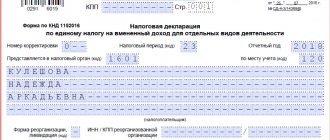Accounting statements in 2020 are formed from the same basic reporting forms as for previous financial years. The information presented in it covers all operations carried out by the company for 2020, including those indicated in interim (usually quarterly) reports, if their presentation is regulated by law or carried out in order to ensure internal control of the company’s activities. This publication will discuss which reporting packages are mandatory for enterprises of different organizational and legal forms.
Composition of the annual financial statements for 2020
The main reports are:
- balance sheet of the enterprise (form No. 1), which gives a general idea of the balances of property, capital and liabilities at the end of the reporting year in comparison with the balances at the beginning. The document is generated in a table, the left side of which contains information about existing assets, and the right side – about their sources. A prerequisite for the formation of a balance sheet is the equality of the parts of the table.
For example, the property in total terms on the balance sheet asset amounted to 12,000 thousand rubles, which means that the balance sheet liability should be the same amount, ensuring that the cost of the property is covered by capital (own and borrowed) and debt to creditors;
- financial results statement (FPR) – form No. 2, which explains to the user what financial flows the company has from different types of activities, and also reflects the total result of the company’s work for the year as a whole. The amounts of profit/loss in the financial financial statements must be correlated with the balance sheet data. For example, the amount of retained earnings in the balance sheet should be equal to the amount of net profit in the general financial market if profits were not distributed in the year.
The annual reporting package is supplemented by annexes to the main forms:
- Form No. 3 – “Report on Changes in Capital” (OIC), detailing the dynamics of changes in all types of capital in the company in the reporting and preceding years. The information in the OIC also corresponds to the balance sheet data on the availability of equity capital, formed in the 3rd section. Thus, lines 3300, 3200, 3100 of the OIC for the corresponding periods and types of capital should be equal to balance sheet lines 1310, 1320, 1350, 1370, 1300;
- Form No. 4 “Cash Flow Statement” (CFDS), reflecting the amount of reserves of cash and cash equivalents quickly converted into money in the company at the beginning and end of the reporting year;
- For non-profit enterprises, a report on targeted financing (form No. 6) is mandatory.
A separate document to the reporting package includes appendices (form No. 5) that decipher the balance sheet and financial information data. Although this document is not officially included in the financial statements, it is often necessary to convey to the regulatory authorities the main details of the company's activities. The reporting and explanations to it are supplemented, which provide an objective assessment of the financial and property status of the company, general information and analysis of the most important indicators.
All reporting forms are approved by Order of the Ministry of Finance of the Russian Federation No. 66n dated July 2, 2010 (as amended on March 6, 2018). It also defines the recommendations and procedure for filling out financial statements, and also presents simplified versions of the balance sheet and financial statements, filled in with grouped values without item-by-item differentiation of data, as should be done when generating familiar reporting documents.
OKVED codes in the financial statements for 2020 are reflected in accordance with the OK 029-2014 classifier (Rosstandart order No. 14-st dated January 31, 2014).
Reporting changes in 2018
Starting this year, new reporting forms for several taxes are being introduced.
Thus, the 4-FSS form, transport tax declaration, and income tax declaration were updated. Declarations for property tax, 3-personal income tax, and land tax were also completely changed. But it should be noted that there are no fundamental changes in these forms. Most of the amendments are related to bringing the form into compliance with the latest amendments and innovations in tax legislation. Usually this came down to introducing new lines into the form.
New forms have also been created that business entities are required to use starting in 2020. This is a new form for calculating insurance premiums, a 2-NDFL certificate, a 6-NDFL declaration, a UTII declaration and others.
For the first time, all business entities that have hired employees are required to submit the SZV-STAZH form this year. Many organizations have already received notification letters from the Pension Fund of the Russian Federation indicating the deadline for sending the report. Such letters were sent both electronically, through EDI systems, and by regular mail. The need for this report arose due to the fact that the previously existing single report was divided into two, one of which must be submitted to the tax office, and the second to the Pension Fund.
Attention! A large number of reports that need to be sent to Rosstat have been updated. Also, starting this year, this department has banned sending zero forms. Therefore, if a company has a form on its list of mandatory forms, but there is no possibility of generating it (for example, the company does not have these objects), then it is necessary to issue a letter explaining why it is impossible to submit this form.
Accounting statements for 2020: who submits them
All legal entities maintain accounting and submit annual reports based on it. This requirement does not apply to individual entrepreneurs - they are completely exempted by the legislator from these responsibilities (subject to keeping records of income and expenses - Article 6 of Law No. 402-FZ of December 6, 2011). We also note that credit institutions and public sector enterprises report using other reporting forms.
At the end of the year, most companies present a full package of these reporting documents. Moreover, if the financial statements of an LLC are presented with this list, then joint-stock companies must attach to the set of reports an auditor’s report confirming the reliability of the given indicators.
Representatives of small businesses - companies with up to 100 employees and a revenue turnover of up to 800 million rubles. per year, has the right to keep simplified records, i.e. submit only simplified balance sheets and financial statements. Small companies may not prepare other forms of reporting. If the activities of such a company are based on the use of targeted budget revenues, then a report on targeted financing is added to the main package of annual reporting. Read more about accounting for small businesses here.
Features of inventory before reporting
Before submitting reports, it is imperative to carry out an inventory. The inventory will allow us to draw conclusions that the reporting is reliable.
An inventory must be carried out in all areas of the enterprise.
When making an inventory of buildings, structures and other real estate, the inventory commission checks the availability of documents confirming the organization’s ownership of the specified objects. The availability of documents for land plots, reservoirs and other natural resource objects owned by the organization is also checked.
Read more Are witnesses needed when drawing up a deed of gift?
If discrepancies are identified between accounting data and inventory data, a matching statement is drawn up
When conducting an inventory of objects of unfinished capital construction, the inventory lists reflect information on the volume of work performed object-by-object. The information is provided by type of work performed, by structural elements, equipment, etc.
The main objectives of the inventory of intangible assets are to check the availability of documents confirming the organization’s rights to them (patents, certificates, contracts for the alienation of the exclusive right to the result of intellectual activity or a means of individualization, etc.), as well as the correctness and timeliness of reflecting intangible assets in the accounting accounting
During the inventory, the presence of the following valuables in the cash register is checked:
— cash;
— monetary documents (postage stamps, paid vouchers to holiday homes and sanatoriums, air and railway tickets, payment cards for communication services, fuel cards, etc.);
— forms of securities;
— forms of strict reporting documents.
The more detailed the inventory is carried out, the better from the point of view of the balance sheet technique.
Deadlines for submitting accounting reports for 2020
The legislator has allowed 3 months after the end of the financial year to prepare accounting reports in both full and simplified form, approve them and submit them to regulatory authorities. Those. All reporting forms for 2020 must be submitted no later than March 31, 2020. But given that this day falls on a Sunday, the last day for submitting financial statements for 2018 will be April 1.
Both in the Federal Tax Service and in the Rosstat department, accounting reports 2018 can be submitted both in paper and electronic format, the number of company personnel does not play a role in this case.
Deadlines for submitting reports to the Pension Fund: table
| Reporting type | Until what date is it provided, taking into account postponements due to holidays and weekends | |||
| For the 1st quarter of 2020 | For the 2nd quarter of 2020 | For the 3rd quarter of 2020 | For the 4th quarter of 2020 or for the year | |
| SZV-M | Jan. 2020 – 02/15/18 Feb. 2020 – 03/15/18 March 2020 -04/16/18 | Apr. 2020 – 05/15/18 May 2020 – 06/15/18 June 2020 – 07/15/18 | July 2020 – 08/15/18 Aug. 2020 – 09/17/18 Sep. 2020 – 10/15/18 | Oct. 2020 – 11/15/18 Nov. 2020 – 12/17/18 Year 2020 – 01/15/19 |
| Information about the insurance experience SZV-STAZH | – | – | – | 01.03.19 |
| Information for individual accounting EFA-1 | – | – | – | 01.03.19 |
Approval of accounting records
The prepared financial statements are signed by the head of the company. Let us remember that it becomes legally significant and actually drawn up only after approval by the top management, for example, by a meeting of shareholders.
The date of approval of the financial statements is indicated in the title of the balance sheet. The legislator has established the deadlines possible for holding a meeting of shareholders - a JSC has the right to hold it no earlier than 2 months after the end of the financial year - from March 1 to June 30 (Article 47 of the Law on JSC dated December 26, 1995 No. 208-FZ) . For LLCs, the period for holding a general meeting of participants is set from March 1 to April 30 after the reporting year (Article 34 of the Law on LLCs dated 02/08/1998 No. 14-FZ). The exact deadlines are established by the charters of the companies.
Rules for preparing financial statements
Submission of tax reports in 2020. is subject to a number of technical rules:
- Blots and corrections are not allowed when filling out forms;
- All data must be provided in rubles. If reporting transactions are carried out in other currencies, then they must be converted into rubles at the rate in effect on the day the report is prepared (the deadline for submitting annual financial statements for 2020 is considered to be the last day of the reporting period, that is, December 31);
- for medium turnover, information is given in thousands of rubles, for large ones it is allowed to give it in millions;
- negative indicators are given in parentheses.
In addition to the technical requirements, there are other rules for submitting financial statements to authorities in 2020:
- the information given at the beginning of the period must coincide with those that appeared in the accounting. documentation at the end of the previous period;
- if the accounting policy of the organization has been changed, this should be reported in an explanatory note;
- offsetting between assets and liabilities, as well as profits and losses, is prohibited unless this is permitted by special accounting rules;
- All numerical data are given in net estimates.
Publicity of financial statements
Since the company’s reporting must be open to all users (participants, creditors, partners, credit institutions, current and potential investors), the legislator in PBU 4/99 (paragraphs 42 - 47) established the obligation to publish it.
Organizations whose publication of information about their activities is mandatory include joint-stock companies, credit institutions, insurance companies, LLCs that issue bonds and other securities. The deadline for publication of accounting (financial) statements for 2020 is no later than June 1, 2020.
2.2. The procedure for drawing up and presenting financial statements
Standard forms of financial statements and instructions on the procedure for filling out these forms are developed and approved by the Ministry of Finance of the Russian Federation.
Ministries and departments of the Russian Federation, republics that are part of the Russian Federation, in addition to standard forms, can establish specialized forms of accounting reporting for organizations of the system in agreement with the ministries of finance of the Russian Federation and the republics that are part of the Russian Federation, respectively.
The organization draws up financial statements reflecting the composition of the property and the sources of its formation, including the property of production facilities, farms, other structural divisions, as well as branches and representative offices that are allocated to a separate balance sheet and are not legal entities.
If an organization has subsidiaries and dependent companies, in addition to its own financial statements, consolidated financial statements are also compiled, including indicators of the reports of such companies located on the territory of the Russian Federation and abroad, in the manner established by the Ministry of Finance of the Russian Federation.
Centralized accounting, serving organizations, draws up financial statements that reflect the composition of the property of these organizations and the sources of its formation.
Ministries, departments and other federal executive authorities draw up consolidated financial statements for organizations for which they are entrusted with coordination and regulation of activities.
Associations of legal entities created on a voluntary basis by organizations (unions, associations) draw up consolidated financial statements in the manner established in the constituent documents of these associations.
The reporting year for all organizations is considered to be the period from January 1 to December 31 inclusive.
The first reporting year for newly created organizations is considered to be the period from the date of their state registration to December 31 inclusive.
Newly created organizations after October 1 are allowed to consider the first reporting year to be the period from the date of their state registration to December 31 of the following year inclusive.
The information contained in the financial statements is based on synthetic and analytical accounting data.
The opening balance sheet data must correspond to the approved closing balance sheet data for the period preceding the reporting period. If the opening balance changes as of January 1 of the reporting year, the reasons should be explained.
Changes in the financial statements relating to both the current and last year (after their approval) are made in the statements prepared for the reporting period in which distortions in its data were discovered.
Corrections of errors in the financial statements are confirmed by the signature of the persons who signed them, indicating the date of correction.
The organization must submit annual financial statements:
1. founders, participants of a legal entity in accordance with the constituent documents;
2. State Tax Inspectorate (one copy). Submission of financial statements to other addresses and with other frequency is carried out in cases provided for by tax and other legislation of the Russian Federation or constituent documents.
In accordance with the resolution of the Government of the Russian Federation (6, paragraph.
3) organizations located on the territory of the Russian Federation, regardless of their organizational and legal form, are required to submit quarterly and annual financial statements starting from January 1, 1996 to the territorial bodies of state statistics at the place of registration of the organization within the time limits established by the Ministry of Finance of the Russian Federation.
The organization submits annual financial statements no later than April 1 of the year following the reporting year, and quarterly financial statements no later than 30 days after the end of the reporting period, unless otherwise provided by the legislation of the Russian Federation.
Within the specified time frame, the specific date for the submission of financial statements is established by the participants (founders) of the organization.
A budgetary organization submits monthly, quarterly and annual accounting reports on the implementation of cost estimates to a higher body within the deadlines established by it, and an organization on the federal budget also submits monthly reports to the territorial body of the federal treasury.
Date of submission
accounting statements for an organization are considered to be the day of its actual transfer by ownership or the date of its departure, indicated on the stamp of the postal organization. If the reporting submission date falls on a non-working (weekend) day, the reporting submission date is considered to be the first working day following it.
Accounting statements are signed
director and chief accountant (accountant) of the organization.
In an organization where accounting is carried out on a contractual basis by a specialized organization or specialist, the financial statements are signed by the head of this organization and the specialist conducting accounting.
The organization's annual financial statements are open to interested users: banks, investors, creditors, buyers, suppliers, etc., who can familiarize themselves with the annual financial statements and receive copies of them with reimbursement for copying costs.
In cases provided for by the legislation of the Russian Federation, the organization publishes annual financial statements no later than June 1 following the reporting year and quarterly financial statements no later than 60 days after the end of the reporting period.
The auditor's report is included in the published financial statements
, confirming its authenticity.
Ministries, departments and other federal executive authorities of the Russian Federation present consolidated quarterly financial statements
for organizations in respect of which they are entrusted with coordination and regulation of their activities, no later than 45 days after the expiration of the reporting period, on an annual basis - no later than April 25 of the following year to the Ministry of Economy of the Russian Federation, the Ministry of Finance of the Russian Federation and the State Statistics Committee of the Russian Federation.
Source: https://StudFiles.net/preview/399553/page:5/












